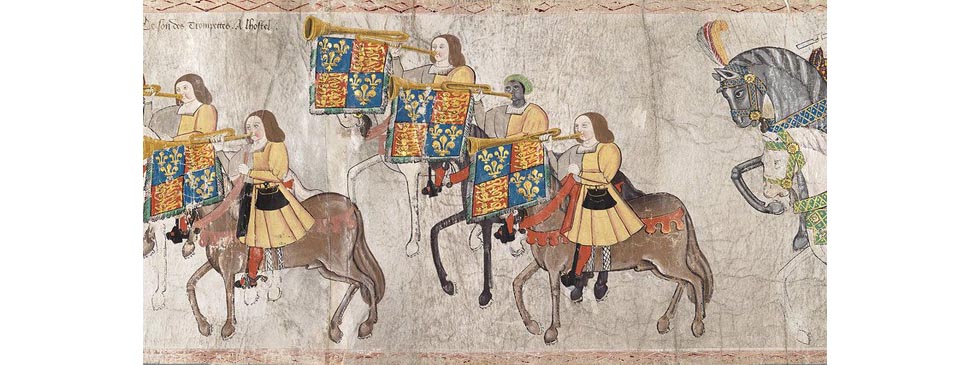Africans in London in the 16th century and the early slave trade

Africans were certainly living in England by the 16th century. A confirmation is within the Westminster Tournament Roll of 1511 where John Blanke is depicted as one of Henry VIII’s trumpeters.
By the end of the 16th century sugar and gold were creating fabulous wealth for investors in Spain and Portugal, far away from the misery inflicted on the slaves who were doing the work. The riches did not go unnoticed by other European maritime nations, particularly in the Netherlands, Britain and France.
The earliest English traders with Africa were from Devon, with voyages financed by merchants from London and Bristol. Sending ships across oceans was an expensive and risky business. Financing, the risks, and the rewards were normally shared by a group of investors. In the 15th century Antwerp was a major financial market, which harnessed the early profits of the slave trade. The financier Thomas Gresham sought to create a similar financial market in London and to achieve that he founded the Royal Exchange, which was formally opened by Queen Elizabeth in 1571. That was where merchants of the late 16th and early 17th century came together to fund voyages.
William Hawkins was the first English seafarer to sail to Guinea in West Africa in 1527 from where he returned with ‘elephant’s teeth’ (ivory) and spices. In the following decades other explorers continued the Guinea trade, including Thomas Wyndham with a young Martin Frobisher on a voyage to Benin funded by the London businessmen Sir John York and George Barne. Only one of the three ships returned and 100 crew died of disease, including Wyndham, but the cargo of melegueta pepper made a good profit for the investors.
Frobisher was again a crew member the following year on a ship owned and captained by John Lok. On a subsequent voyage in 1555 Lok returned to London with five high-status Africans from Shama in modern-day Ghana but “the cold and moist air doth somewhat offend them”. Having learned English, three returned home the following year with the trader William Towerson to act as interpreters.
Unlike Portugal, England did not then have a foothold in Africa or the Americas from which to regularly capitalize but English ships could profit by plundering Portuguese vessels sailing from there. Financed by the London investors Sir Lionell Ducket, Sir Thomas Lodge, Sir William Winter, Mr. Gunson, Mr. Blomfield and others, in 1562 John Hawkins, son of William and cousin of Francis Drake, sailed with three ships – the Salomon, the Swallow, and the Jonas – to Guinea. At the Canary Islands Hawkins heard there was a strong demand for slaves in Spanish Hispaniola. In October he captured a Portuguese ship off Sierra Leone with 200 slaves aboard, and he came by a further 140 slaves on two ships in December. The slaves were sold to plantation owners in the Caribbean the following year. He returned to England in 1563 laden with ginger, sugar, pearls and hides that were sold for a considerable profit. A further, less successful voyage, was made a year later. It was England’s first incursion into a trade they would later come to dominate.
In 1566 John Hawkins sponsored John Lovell to sail with a small fleet, with Drake as one of the crew. Over several months they plundered six Portuguese ships, capturing sugar and slaves. Queen Elizabeth provided one of her ships, the Jesus of Lubeck, and probably took a share of the profits. However, the Spanish Crown decreed that their colonies should not buy slaves from English Protestant privateers and interlopers. They refused to trade so Lovell abandoned 92 of the slaves and returned back to England with others.
Hawkins kept 50 of the unsold slaves at Plymouth for a few weeks before setting sail with them again, together with two ships from Queen Elizabeth in the fleet. This time Drake captained the Judith. By January 1568 they had captured 150 slaves from Portuguese ships around the African coast. Working together with a local tribe in Sierra Leone a rival village was destroyed and a further 250 prisoners taken to sell as slaves. They were sold on the Caribbean coast of modern-day Columbia and Santa Maria but the voyage ended in disaster, however, when the ships were attacked by a Spanish fleet. Those carrying Hawkins and Drake escaped but others were sunk. On subsequent voyages Drake continued to plunder Spanish ships but never taking slaves.
In 1578 Elizabeth appointed John Hawkins as Treasurer to the Navy, during which time he lived at the Treasurers House by the Thames at Deptford. He received a knighthood for his involvement in the defence of the Armada. John’s elder brother William died at Deptford in 1589 and John erected a monument to him at St. Nicholas church, although there is now no trace of it.
In 1588 a group of merchants from London and Devon established the Guinea Company and were granted by Queen Elizabeth exclusive rights to trade with West Africa for ten years.
Attacks on Spanish ships by English privateers continued until the end of Elizabeth’s reign. In 1600 the crew of the Golden Phoenix, owned by the London merchant Paul Bayning, seized a ship near Barbados carrying at least 125 slaves, which they sold in exchange for pearls at La Margarita off the coast of Venezuela.


